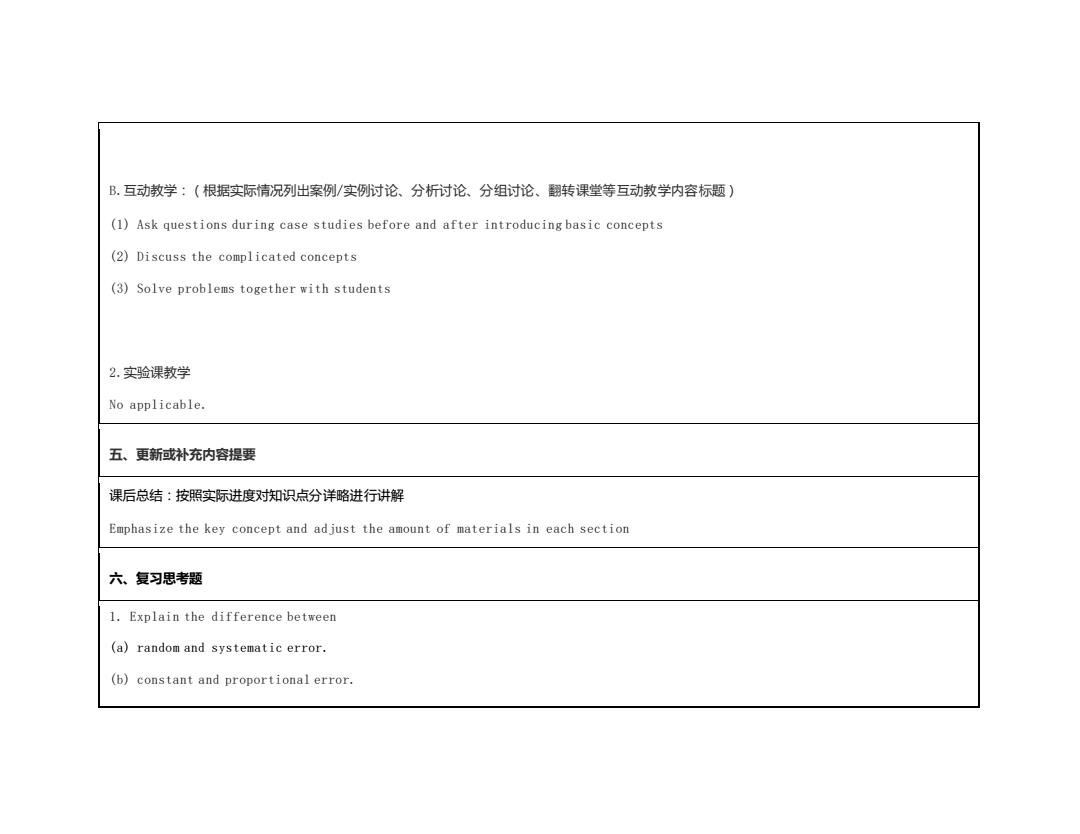
B.互动教学:(根据实际情况列出案例/实例时论、分析讨论、分组讨论、翻转课堂等互动教学内容标题) (1)Ask questions during case studies before and after introducing basic concepts (2)Discuss the complicated concepts (3)Solve problems together with students 2.实验课教学 No applicable. 五、更新或补充内容提要 课后总结:按照实际进度对知识点分详略进行讲解 Emphasize the key concept and adjust the amount of materials in each section 六、复习思考题 1.Explain the difference between (a)random and systematic error. (b)constant and proportional error
B.互动教学:(根据实际情况列出案例/实例讨论、分析讨论、分组讨论、翻转课堂等互动教学内容标题) (1) Ask questions during case studies before and after introducing basic concepts (2) Discuss the complicated concepts (3) Solve problems together with students 2.实验课教学 No applicable. 五、更新或补充内容提要 课后总结:按照实际进度对知识点分详略进行讲解 Emphasize the key concept and adjust the amount of materials in each section 六、复习思考题 1. Explain the difference between (a) random and systematic error. (b) constant and proportional error
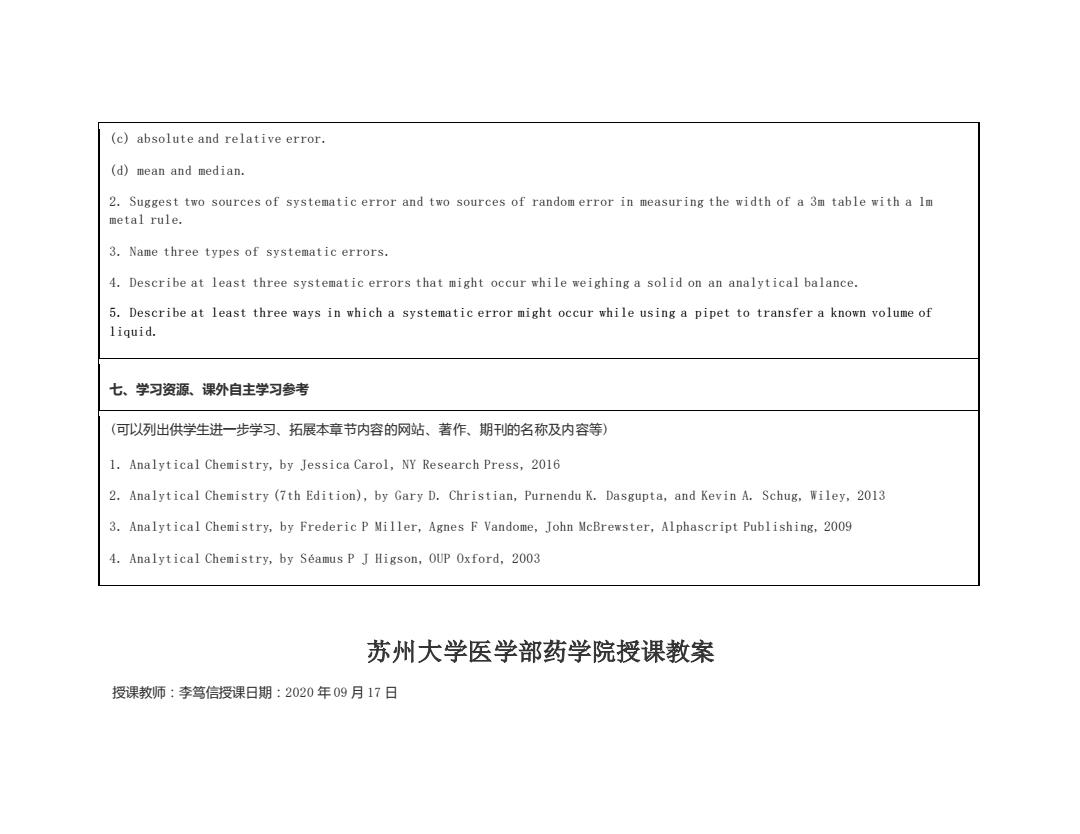
(c)absolute and relative error. (d)mean and median. 2.Suggest two sources of systematic error and two sources of random error in measuring the width of a 3m table with a Im metal rule. 3.Name three types of systematic errors. 4.Describe at least three systematic errors that might occur while weighing a solid on an analytical balance. 5.Describe at least three ways in which a systematic error might occur while using a pipet to transfer a known volume of liquid. 七、学习资源、课外自主学习参考 (可以列出供学生进一步学习、拓展本章节内容的网站、著作、期刊的名称及内容等) 1.Analytical Chemistry,by Jessica Carol,NY Research Press,2016 2.Analytical Chemistry (7th Edition),by Gary D.Christian,Purnendu K.Dasgupta,and Kevin A.Schug,Wiley,2013 3.Analytical Chemistry,by Frederic P Miller,Agnes F Vandome,John McBrewster,Alphascript Publishing,2009 4.Analytical Chemistry,by Seamus P J Higson,OUP Oxford,2003 苏州大学医学部药学院授课教案 授课教师:李笃信授课日期:2020年09月17日
(c) absolute and relative error. (d) mean and median. 2. Suggest two sources of systematic error and two sources of random error in measuring the width of a 3m table with a 1m metal rule. 3. Name three types of systematic errors. 4. Describe at least three systematic errors that might occur while weighing a solid on an analytical balance. 5. Describe at least three ways in which a systematic error might occur while using a pipet to transfer a known volume of liquid. 七、学习资源、课外自主学习参考 (可以列出供学生进一步学习、拓展本章节内容的网站、著作、期刊的名称及内容等) 1. Analytical Chemistry, by Jessica Carol, NY Research Press, 2016 2. Analytical Chemistry (7th Edition), by Gary D. Christian, Purnendu K. Dasgupta, and Kevin A. Schug, Wiley, 2013 3. Analytical Chemistry, by Frederic P Miller, Agnes F Vandome, John McBrewster, Alphascript Publishing, 2009 4. Analytical Chemistry, by Séamus P J Higson, OUP Oxford, 2003 苏州大学医学部药学院授课教案 授课教师:李笃信授课日期:2020 年 09 月 17 日
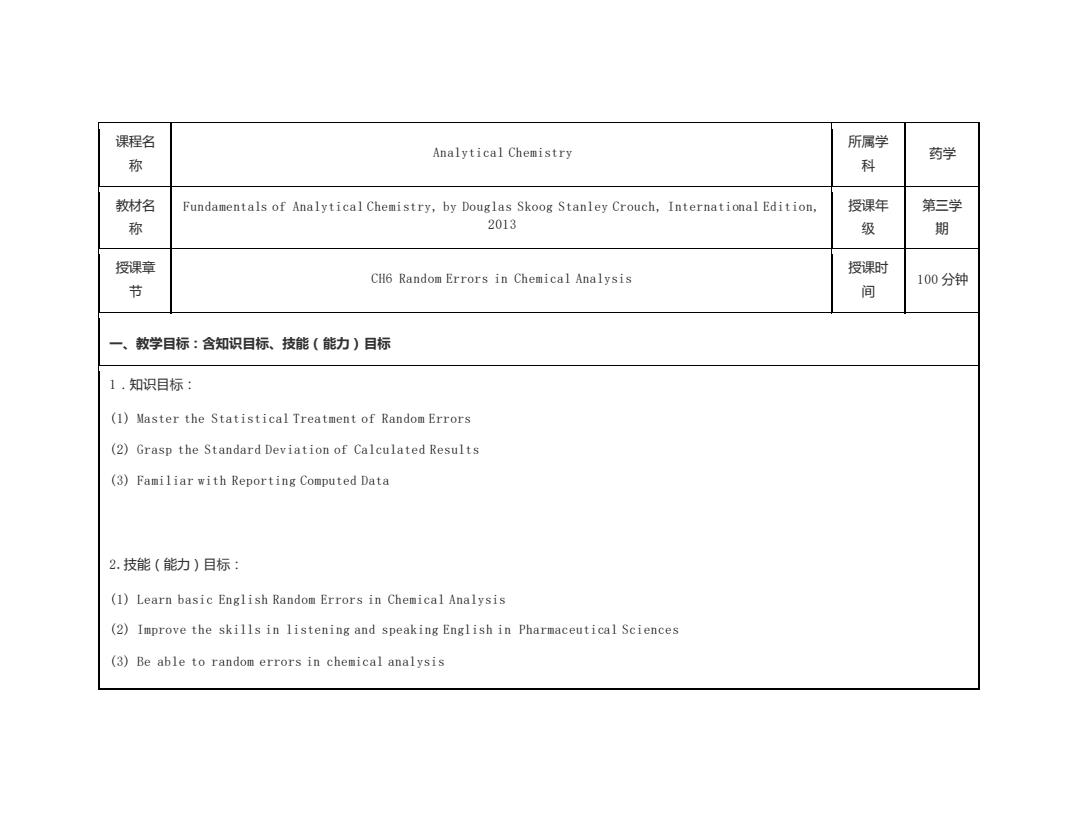
课程名 所属学 Analytical Chemistry 称 药学 科 教材名 Fundamentals of Analytical Chemistry,by Douglas Skoog Stanley Crouch,International Edition, 授课年 第三学 称 2013 级 期 授课章 授课时 CH6 Random Errors in Chemical Analysis 100分钟 节 间 一、教学目标:含知识目标、技能(能力)目标 1.知识目标: (1)Master the Statistical Treatment of Random Errors (2)Grasp the Standard Deviation of Calculated Results (3)Familiar with Reporting Computed Data 2.技能(能力)目标: (1)Learn basic English Random Errors in Chemical Analysis (2)Improve the skills in listening and speaking English in Pharmaceutical Sciences (3)Be able to random errors in chemical analysis
课程名 称 Analytical Chemistry 所属学 科 药学 教材名 称 Fundamentals of Analytical Chemistry, by Douglas Skoog Stanley Crouch, International Edition, 2013 授课年 级 第三学 期 授课章 节 CH6 Random Errors in Chemical Analysis 授课时 间 100 分钟 一、教学目标:含知识目标、技能(能力)目标 1.知识目标: (1) Master the Statistical Treatment of Random Errors (2) Grasp the Standard Deviation of Calculated Results (3) Familiar with Reporting Computed Data 2.技能(能力)目标: (1) Learn basic English Random Errors in Chemical Analysis (2) Improve the skills in listening and speaking English in Pharmaceutical Sciences (3) Be able to random errors in chemical analysis
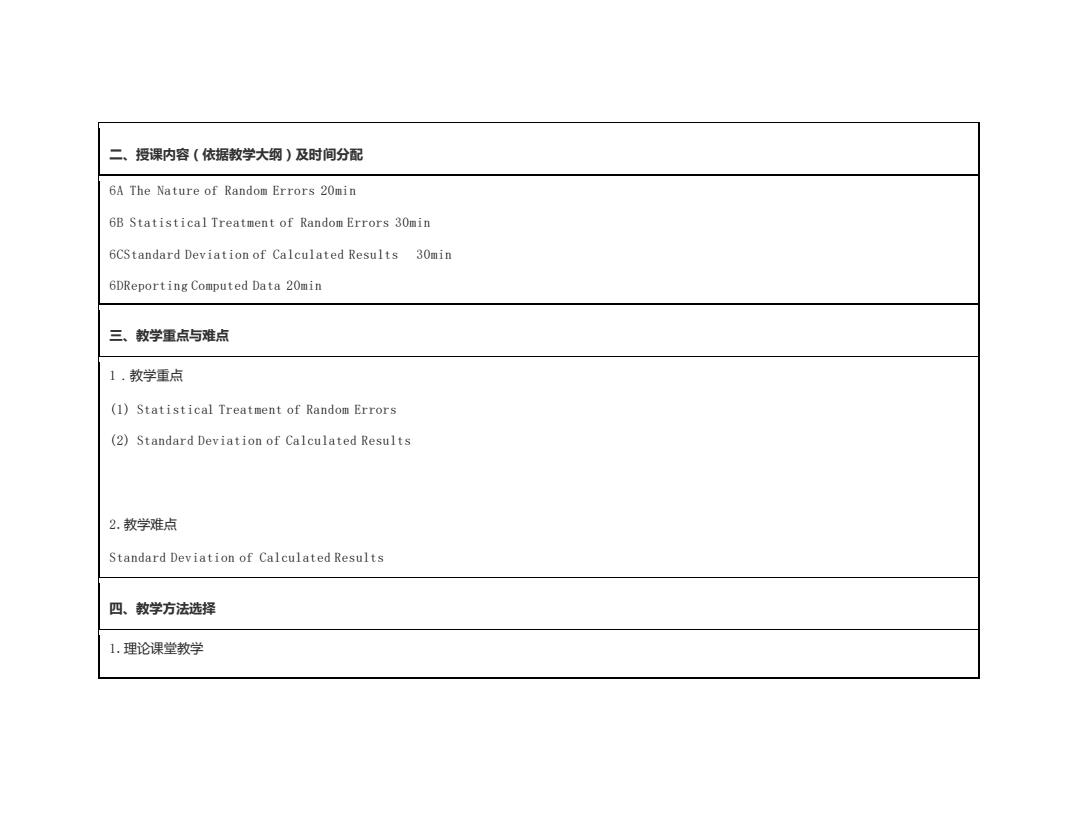
二、授课内容(依据教学大纲)及时间分配 6A The Nature of Random Errors 20min 6B Statistical Treatment of Random Errors 30min 6CStandard Deviation of Calculated Results 30min 6DReporting Computed Data 20min 三、教学重点与难点 1.教学重点 (1)Statistical Treatment of Random Errors (2)Standard Deviation of Calculated Results 2.教学难点 Standard Deviation of Calculated Results 四、教学方法选择 1.理论课堂教学
二、授课内容(依据教学大纲)及时间分配 6A The Nature of Random Errors 20min 6B Statistical Treatment of Random Errors 30min 6CStandard Deviation of Calculated Results 30min 6DReporting Computed Data 20min 三、教学重点与难点 1.教学重点 (1) Statistical Treatment of Random Errors (2) Standard Deviation of Calculated Results 2.教学难点 Standard Deviation of Calculated Results 四、教学方法选择 1.理论课堂教学
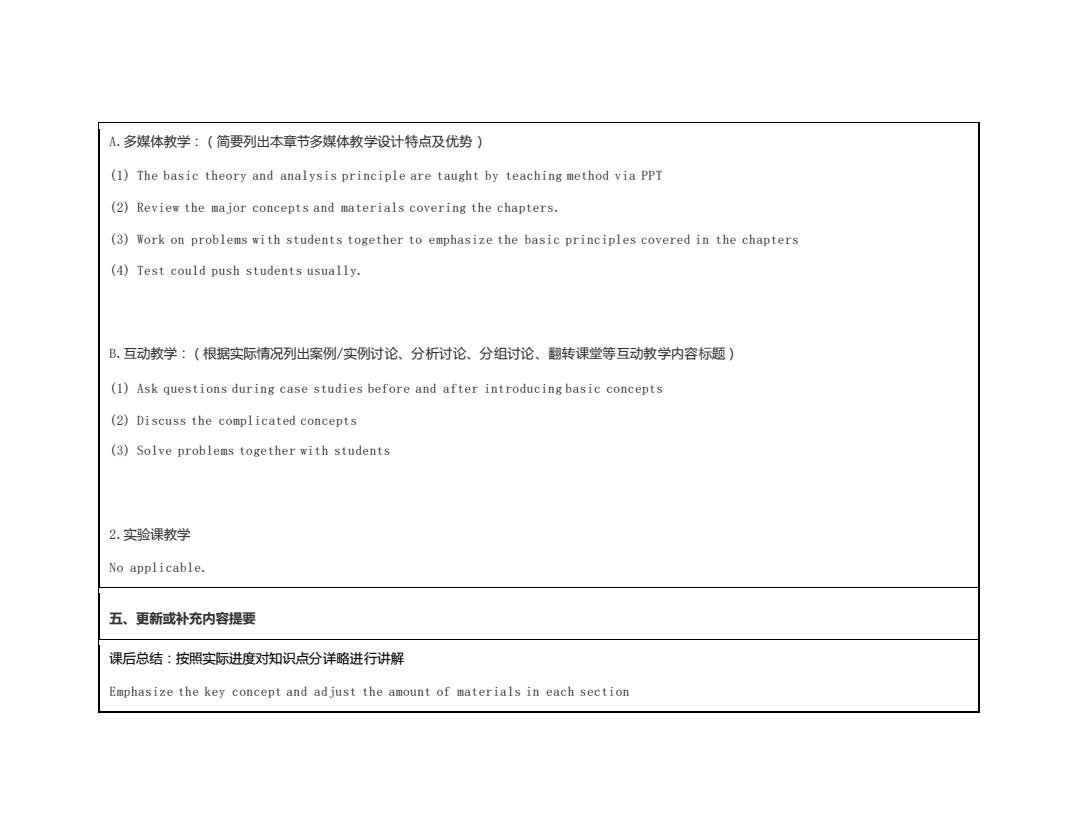
A.多媒体教学:(简要列出本章节多媒体教学设计特点及优势) (1)The basic theory and analysis principle are taught by teaching method via PPT (2)Review the major concepts and materials covering the chapters. (3)Work on problems with students together to emphasize the basic principles covered in the chapters (4)Test could push students usually. B.互动教学:(根据实际情况列出案例/实例时论、分析讨论、分组讨论、翻转课堂等互动教学内容标题) (1)Ask questions during case studies before and after introducing basic concepts (2)Discuss the complicated concepts (3)Solve problems together with students 2.实验课教学 No applicable. 五、更新或补充内容提要 课后总结:按照实际进度对知识点分详略进行讲解 Emphasize the key concept and adjust the amount of materials in each section
A.多媒体教学:(简要列出本章节多媒体教学设计特点及优势) (1) The basic theory and analysis principle are taught by teaching method via PPT (2) Review the major concepts and materials covering the chapters. (3) Work on problems with students together to emphasize the basic principles covered in the chapters (4) Test could push students usually. B.互动教学:(根据实际情况列出案例/实例讨论、分析讨论、分组讨论、翻转课堂等互动教学内容标题) (1) Ask questions during case studies before and after introducing basic concepts (2) Discuss the complicated concepts (3) Solve problems together with students 2.实验课教学 No applicable. 五、更新或补充内容提要 课后总结:按照实际进度对知识点分详略进行讲解 Emphasize the key concept and adjust the amount of materials in each section